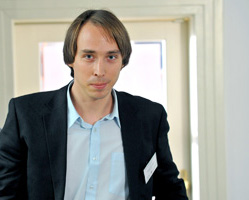
Jakub Mlynar
Jakub Mlynar works with USC Shoah Foundation across the world from the majority of its staff, but his enthusiasm can be felt all the way from the Czech Republic.
Mlynar is the coordinator of the Malach Center for Visual History, a Visual History Archive access site located at Charles University in Prague. He is also its 2013 teaching fellow, preparing to teach a sociology course using the Visual History Archive next winter.
At the Malach Center, Mlynar introduces new users to the 52,000 testimonies of genocide survivors in the Visual History Archive, gives presentations about its use to faculty, students and other groups, and promotes its activities throughout the Czech Republic.
Mlynar and his colleague Petra Hoffmanova also created a contest for Czech students to draw one-page cartoons exploring the themes of the Holocaust and human rights.
“Comics as a medium has some very specific limitations and it was wonderful to see how the students used their creativity to make the most of one page. Some of the works are truly breathtaking,” Mlynar said.
Mlynar’s sociology course will be called "Identities, Memories, and Narratives in Society.” It is focused on the sociological dimension of the concept of identity. Testimonies in the Visual History Archive will provide material for the research and illustration of social, linguistic and narrative means of the process of identity construction. The course will take place in the Malach Center, so that the Visual History Archive is available during all lectures.
Working in the Malach Center daily provides Mlynar opportunities to interact with a wide variety of people who are using the Visual History Archive. He says it’s gratifying to meet teachers and researchers who understand the importance of testimony across many fields and disciplines.
He also has the chance to meet many Holocaust survivors themselves. Mlynar remembers one Czech survivor (who had given testimony to the Visual History Archive) who came into the center and listened to her brother’s testimony for the first time. For an emotional 15 minutes in his testimony, he talks about being forced to bury villagers killed by the Nazis.
Mlynar recalled, “’This is something that I never heard before,’ said his sister, when she put the headphones aside. ‘He never told us what he did in Lidice. When my brother came back to Theresienstadt, he just said: 'Yes, I was in Lidice, but please, never ask me, what did I see there. I will never tell,'’” Mlynar said. “And he never spoke about it in the circle of his family, but he included the horrifying experience in his VHA testimony.”
Testimony allows people to understand and appreciate how ordinary people lived through and understood historical events, Mlynar said. It’s also an “outstanding” tool to deconstruct and disrupt stereotypes – an especially important task in contemporary Czech Republic.
“In the past few years, especially the anti-Roma prejudice and hatred is spreading through the internet and mass-media, being more and more tolerated as a rightful and acceptable attitude,” Mlynar said. “The specific formal mechanisms of propaganda, social exclusion and marginalization surely changed in the last 100 years, but some of the aspects remain strikingly similar. This is something that the educational work with the Visual History Archive allows us to analyze, explore and uncover.”